Healthcare Trends 2025


As per Harvard Business Review, the healthcare industry has the lowest labor productivity growth, three times lower than the US average value across different industries. The low pace of technology adoption is one of the reasons for the poor labor performance.
Hence, healthcare providers rapidly adopt new technologies to improve performance, achieve better patient outcomes, and reduce the number of errors.
In the post below, you will find the top healthcare industry trends in 2025, arranged by the compound annual growth rate (CAGR). Discover what to expect in the future and what technologies will shape the industry’s future.
Artificial Intelligence — CAGR 37.5%
Artificial intelligence (AI) and machine learning (ML) is a growing healthcare trend. The technologies foresee the opportunity to analyze large datasets of patient data to reap insights.
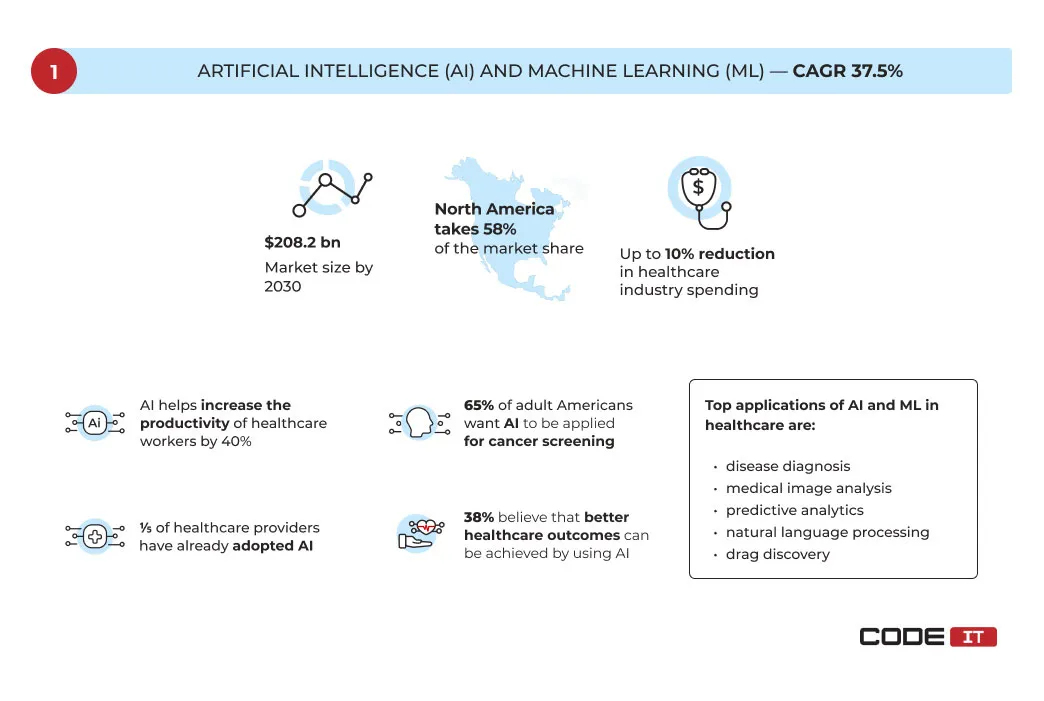
The top applications of AI and ML in healthcare are:
- disease diagnosis
- medical image analysis
- predictive analytics
- natural language processing
- drag discovery
build AI-driven healthcare system
Healthcare statistics 2025 say the AI healthcare market is expected to reach $208.2 billion by 2030 at a CAGR of 37.5%. The largest share of the market is dedicated to North America and accounts for 58%.
According to the report prepared by a specialist from McKinsey & Company and Harvard University, the implication of AI can help save up to $360 billion annually, which accounts for 10% of the healthcare industry spending.
The Pew Research Center states that 65% of adult Americans want AI to be applied for cancer screening; 38% of respondents say they believe that better healthcare outcomes can be achieved when using artificial intelligence in healthcare.
As per the report from International Health, the usage of AI-enabled tools could help increase the productivity of healthcare workers by 40%, on average.
Statista says that a ? of healthcare providers have already adopted AI model usage into their workflows.
When you have technology that’s learning from looking at millions and millions of patients, it becomes incredibly proficient.
Blockchain — CAGR 34%
Blockchain offers the opportunity to create secured records, enhancing overall security. The top security is ensured by the architecture of blockchain-enabled systems that rely on a decentralized network of computers.

Using a decentralized system, healthcare providers can enable:
- secured electronic health records
- supply chain transparency
- medical data integrity
- safe transactions
- minimized fraud claims
Statistics on 2025 healthcare trends say that the market share is about to reach $14 billion by 2032 at a CAGR of 34%.
The insights shared by Statista say that 39.5% of healthcare vendors have already deployed blockchain-driven technologies; 55% are expected to adopt blockchain-driven technologies by the year 2025.
According to BIS research, the industry is expected to save up to $150 billion annually using blockchain in healthcare to reduce the number of fraud and data breach cases.
Internet Of Medical Things — CAGR 29.5%
The Internet of Medical Things (IoMT) term defines medical devices connected into one system using networks. IoMT devices are useful for remote patient monitoring and data transfer.
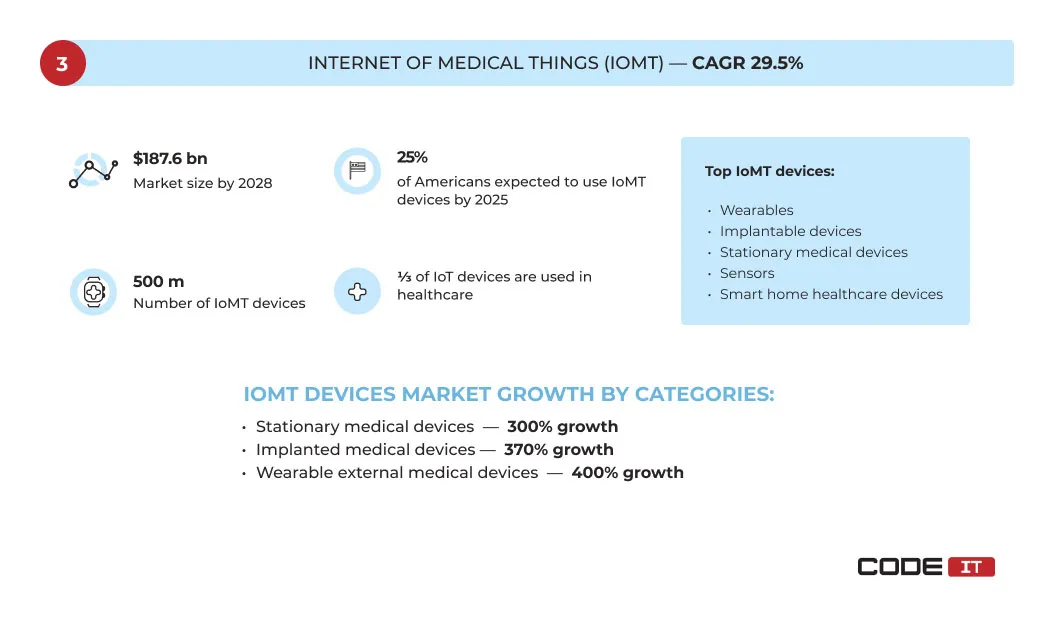
The foremost types of devices that can be connected to an IoMT infrastructure are:
- wearables
- implantable devices
- stationary medical devices
- sensors
- smart home healthcare devices
As one of the top healthcare trends in 2025, the IoMT market is expected to reach the $187.6 billion milestone in 2028, statistics say.
25% of Americans are expected to use devices that track, collect, and share medical data by 2025, the research from Insider Intelligence says.
According to a report prepared by Deloitte, there are more than 500 million medical devices used by healthcare organizations. Also, the report specifies the growth of IoMT devices markets by categories for the last five years.
- Stationary medical devices — 300% growth
- Implanted medical devices — 370% growth
- Wearable external medical devices — 400% growth
As per Frost & Sullivan’s research, roughly a 30.3% of all IoT devices are deployed in healthcare organizations.
Augmented Reality And Virtual Reality — CAGR 27.2%
VR and AR technologies help create a virtual reality environment or supplement real surroundings with virtual objects. VR and AR technologies are widely used in medical training and education.
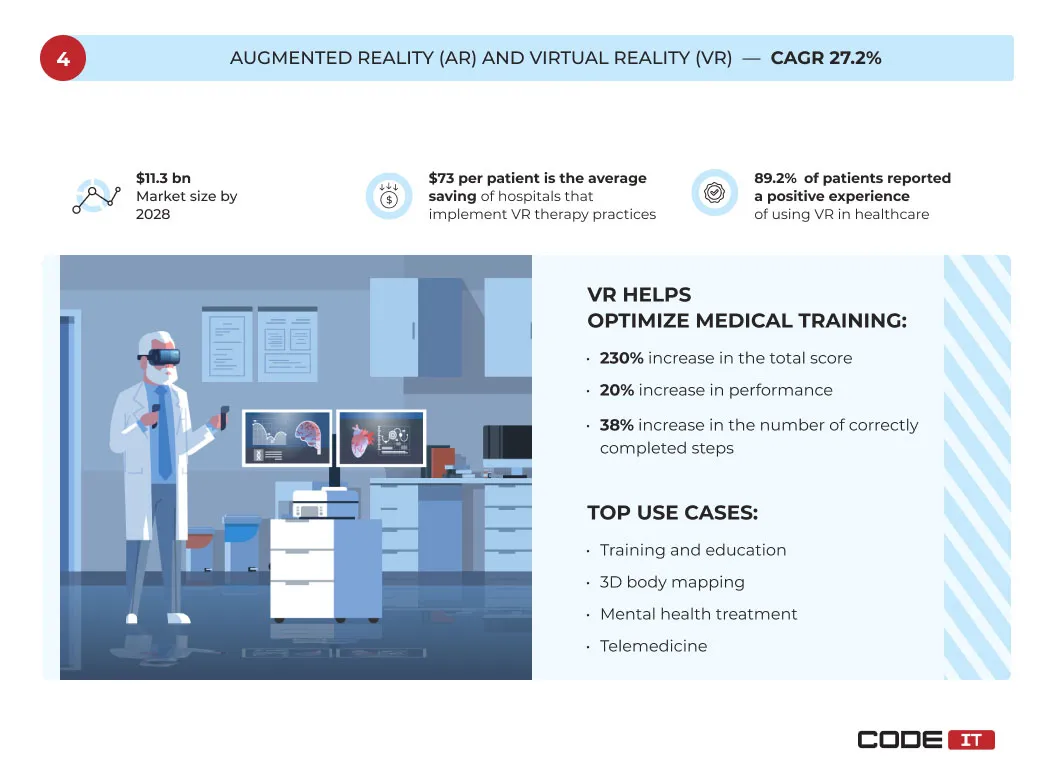
The top use cases of these technologies are as follows.
- Training and education
- 3D body mapping
- Mental health treatment
- Telemedicine
Statistics say that the market size is expected to reach $11.3 billion in 2028. Half of the market share is dedicated to North America.
The research conducted by Harvard Business Review indicates that VR positively impacts the surgeon training process. Let’s check the stats to explore the results of VR-trained groups compared to traditionally-trained groups.
- 230% increase in the total score
- 20% increase in performance
- 38% increase in the number of correctly completed steps
Nature estimates that hospitals that implement VR therapy programs save $73 per patient.
Frontiersin, one of the largest research publishers, says that 89.2% of patients reported a positive experience of using VR headsets for healthcare purposes.
Wearable Technologies — CAGR 26.4%
Wearables in healthcare are vastly represented by smart devices and sensors with wireless connectivity to share data. They collect medical data and share it with healthcare providers in real time.
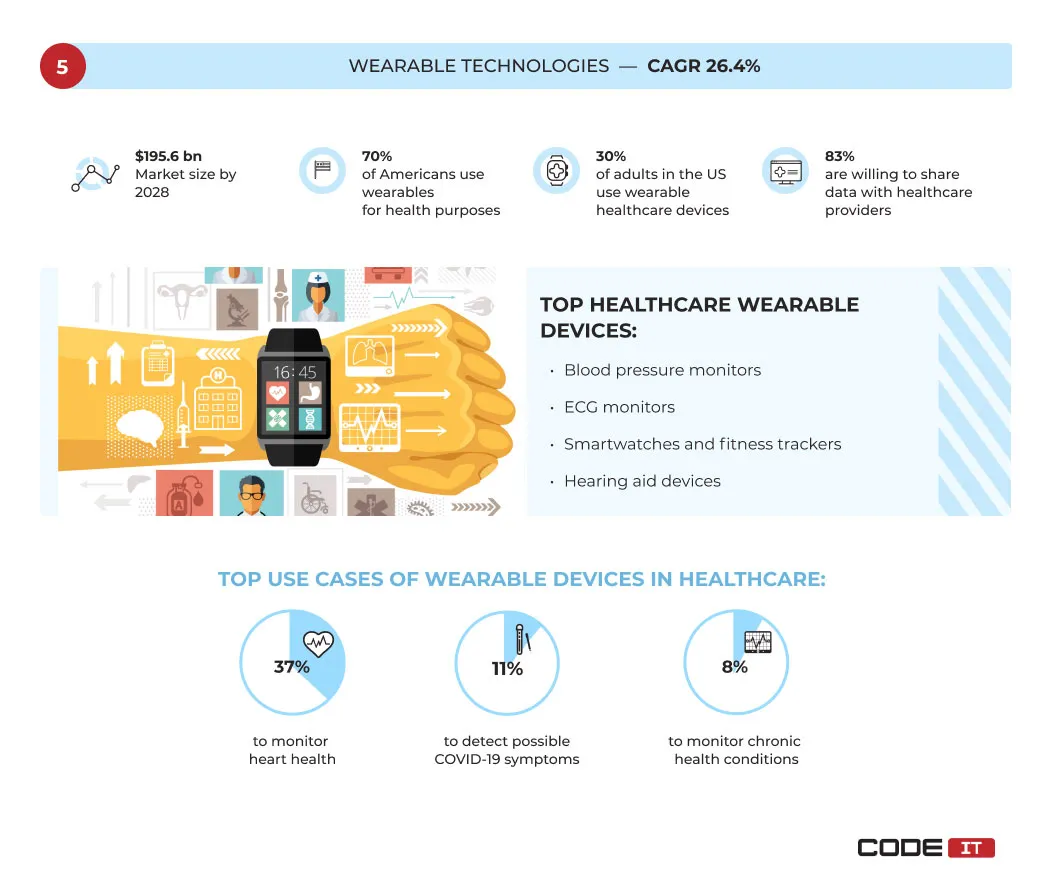
The most popular healthcare wearable devices are:
- smartwatches and fitness trackers
- blood pressure monitors
- ECG monitors
- hearing aids
GlobeNewswire states that the market is expected to reach $195.6 billion by 2027.
70% of Americans state that wearables help improve their health, the Deloitte survey says.
According to the research published in the Journal of Internet Medical Research, 30% of adults in the US use wearable healthcare devices. Moreover, roughly 83% of respondents are willing to share collected data with their healthcare providers.
In the survey taken by Delloite, smartwatch owners use their devices for tracking their health, including:
37% — to monitor heart health
11% — to detect possible COVID-19 symptoms
8% — to monitor chronic health conditions
Telemedicine — CAGR 25.7%
Telemedicine defines remote medical consultations that are held over the Internet. Telehealth sessions imply remote consultation, surveying, guidance, etc.
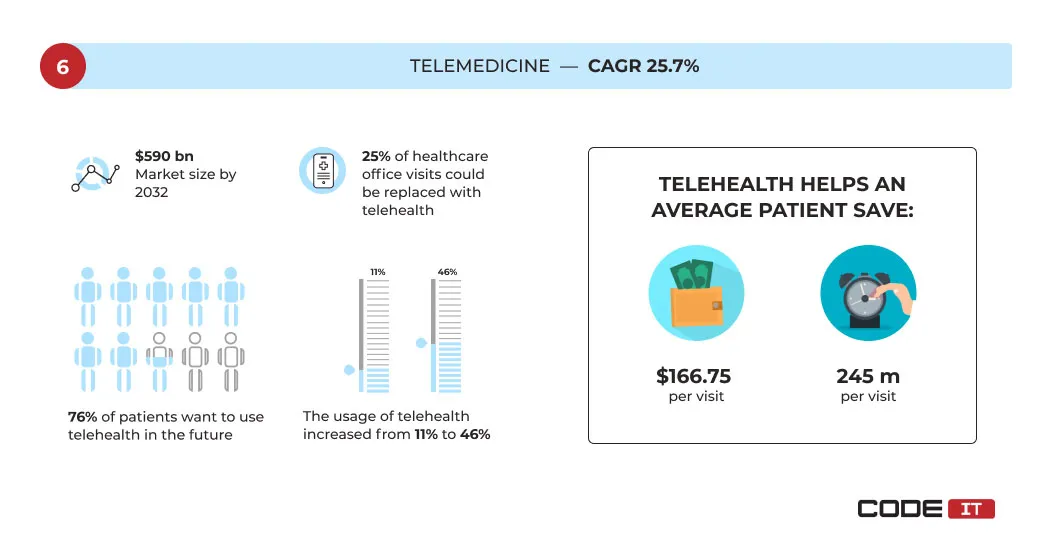
The market of telehealth devices grows at a CAGR of 25.7% and is expected to reach $590.9 billion by 2032, statistics say.
As per the McKinsey & Company report, the usage rate of telehealth solutions among patients increased from 11% to 46% during the COVID-19 outbreak. 76% of patients indicated that they are likely to use telemedicine app development solution in the future.
Moreover, the research indicates that roughly a ¼ of healthcare office visits could be potentially replaced with telehealth sessions, which makes telehealth one of the fastest-growing healthcare trends in 2025.
According to the Journals of the American Medical Association (JAMA) network, telehealth technologies help patients save $166.75 per visit, on average.
The research published in ScienceDirect estimates that a patient who uses telemedicine saves 245 minutes or 4 hours and 5 minutes per visit, on average. The time saved includes traveling and waiting in a hospital.
Big Data Analytics — CAGR 24.3%
Big data analytics is the process of analyzing large datasets to reap insights, build predictive models, optimize processes, etc.
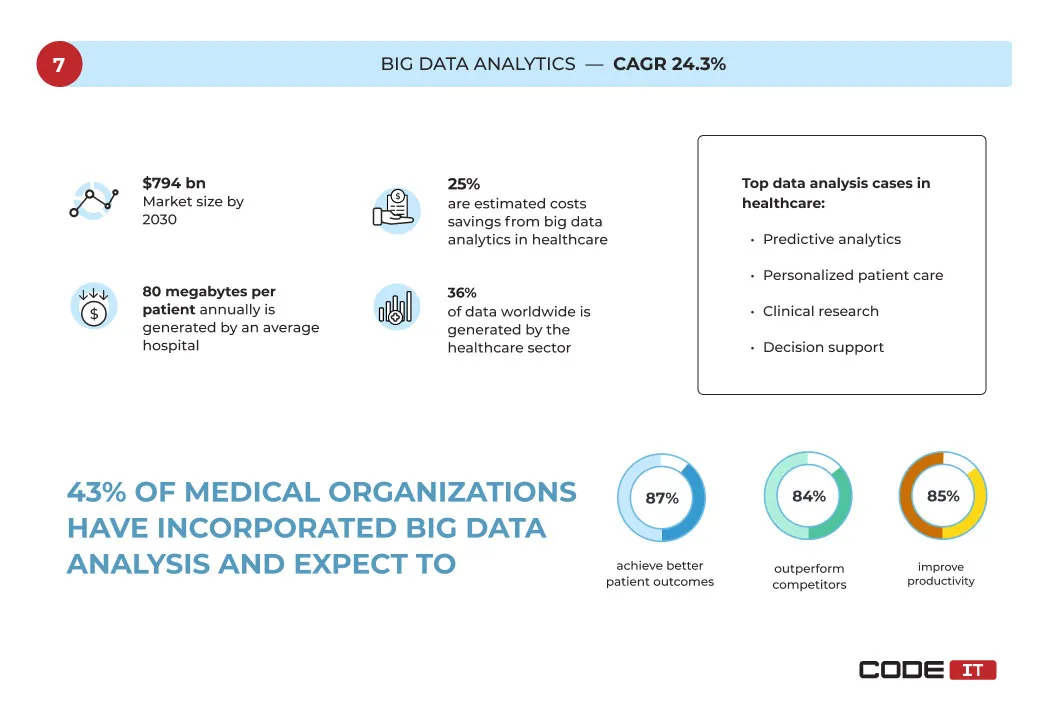
Statistics on the healthcare trends in the United States say the market is expected to increase 3.7 times from 2023 to 2030, reaching $794.08 billion.
The healthcare sector is the largest contributor to the amount of the world’s data. Nick Culbertson, a Forbes council member, states that healthcare data accounts for roughly a third of all the global data. Moreover, he projects that 36% of all the data generated will be dedicated to the healthcare industry by 2025. Also, the research says that healthcare organizations generate roughly 80 megabytes per patient annually.
Let’s check how big data analytics contributes to healthcare by exploring the top use cases.
- Predictive analytics
- Personalized patient care
- Clinical research
- Decision support
The research published in the Journal of Big Data indicates that the implication of big data analytics could help healthcare providers cut their expenses by 25%.
As per the Regis College research, 43% of US healthcare organizations have incorporated predictive analytics into their workflows. Furthermore, the report indicates that:
- 87% of healthcare providers expect to achieve better patient outcomes using big data analytics
- 84% expect to outperform competitors, using big data analytics
- 85% highlight that the analysis of big data in healthcare helps improve productivity
Mobile Healthcare — CAGR 22.3%
Mobile health (mHealth) defines the usage of mobile devices to provide and receive medical services. Mobile apps can collect medical data, conduct image analysis, and run telemedicine sessions.
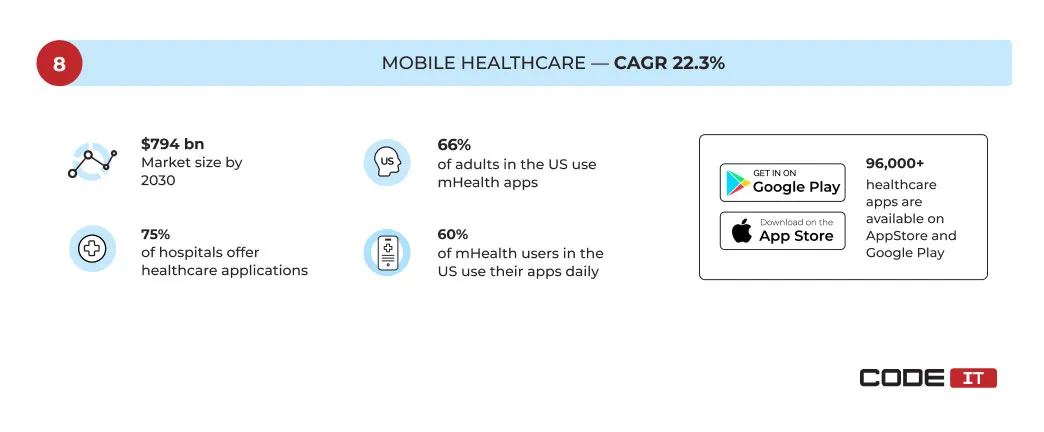
There are many types of mobile healthcare apps, including:
- doctor appointment apps
- telehealth apps
- patient portals
- messaging apps
- education apps
Statistics on 2025 healthcare trends say that the mobile healthcare market is expected to expand ten times by 2030, surpassing.
There are more than 96,000 digital health and medical apps available on Google Play and AppStore platforms collectively, Statista says.
Insider intelligence says that roughly two-thirds of adults in the US have mHealth applications installed on their smartphones. Also, the research indicates that roughly 6 out of 10 mHealth app users utilize healthcare applications on their mobile devices daily.
As per statistics offered by the National Library of Medicine, 75% of hospitals offer access to mobile applications.
E-Prescribing — CAGR 21%
E-prescribing defines the usage of digital tools and systems to administer medications electronically. Also, digital solutions help automate workflows to reduce the administrative burden.
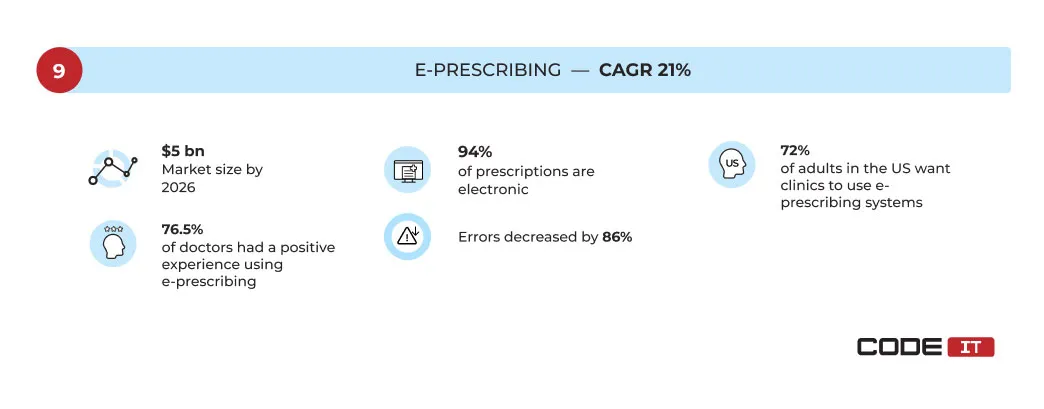
They foresee the opportunity for doctors to electronically prescribe medications and submit requests to pharmacies and other medicine dispensing units.
According to statistics, the e-prescribing market is growing fast at a CAGR of 21% and is expected to reach $4 billion by 2026.
Statista says that more than 94% of all prescriptions are electronic, highlighting the fact that it is a top healthcare trend in 2025.
As per a study published on PLOS ONE, 76.5% of doctors had positive experiences using e-prescribing systems, compared to paperwork. Also, it highlights that e-prescribing helps decrease errors by 86%.
Roughly 72% of adults in the US want healthcare providers to prescribe medications electronically, HIT Consultant says.
Cloud Infrastructure — CAGR 17.6%
The usage of cloud infrastructure provides access to scalable, highly-effective, and secured solutions for storing and processing healthcare data in remote data centers.
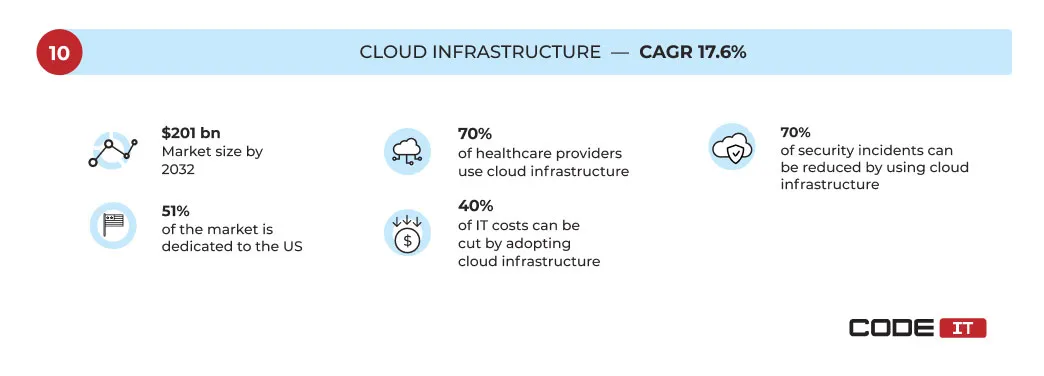
As stated by GlobeNewswire, the global healthcare cloud computing market is expected to reach $201 billion by 2032. North America accounts for 51.0% of the market share. Another GlobeNewswire report says that 70% of healthcare providers already use cloud infrastructure; 20% plan to adopt it in the near future.
The adoption of cloud infrastructure helps save up to 40% of IT costs, McKinsey and Company says. Also, it can potentially help reduce the number of security incidents by 70%.
Security And Compliance — CAGR 14.2%
Security and regulatory compliance are a required component of every healthcare solution. Healthcare since medical organizations have to store and process large amounts of sensitive data of their patients.
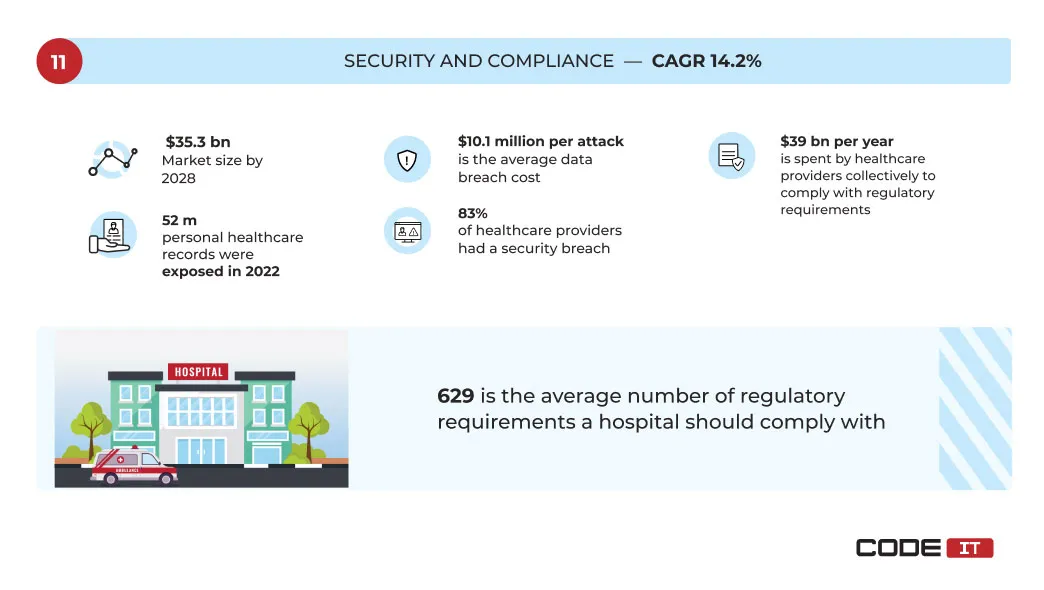
Also, healthcare providers are obligated to comply with many standards. HIPAA compliance is a major requirement for medical organizations in the US.
Healthcare statistics 2025 say that the healthcare cybersecurity market is estimated to be worth $35.3 billion by 2028.
52 million personal healthcare records were exposed in 2022 because of security breaches, HealthcareDive says.
As per IBM research, the healthcare industry has the highest average data breach cost, which accounts for $10.1 million per attack. Also, the report says that 83% of interviewed healthcare providers had a security breach at least once.
The research conducted by the American Hospital Association reveals that an average hospital in the US has to comply with 629 regulatory requirements. Furthermore, the report states that all healthcare providers collectively spend $39 billion per year on administrative activities to comply with all the requirements.
Medical Data Interoperability — CAGR 12.9%
Interoperability in healthcare defines the opportunity for hospitals and medical organizations to exchange data without losing its unambiguous meaning. Coding and data interoperability rules help connect software that is built by using different technologies.
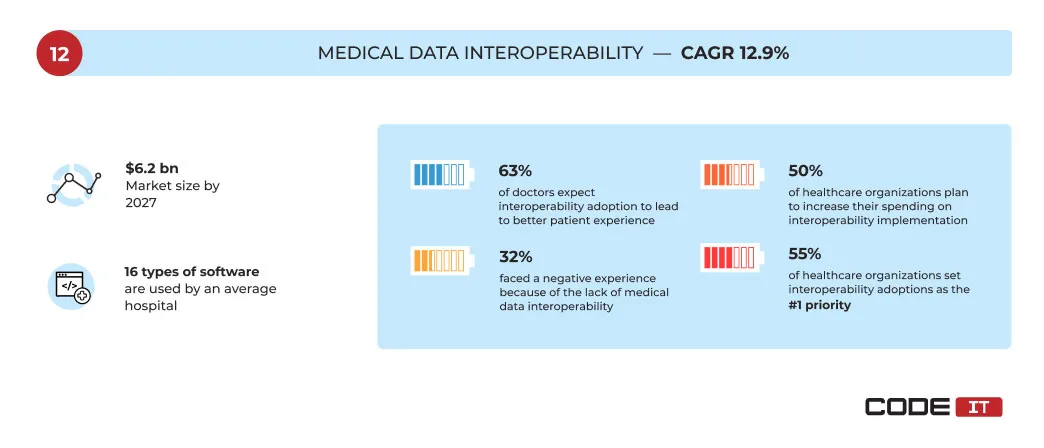
The medical data interoperability market is growing steadily at a CAGR of 12.9%, statistics say. Also, it is estimated to have reached $6.2 billion in 2027.
The three layers of interoperability are:
- Foundational interoperability — the ability of different systems to exchange data via networks or point-to-point connections.
- Structural interoperability — the ability of systems that use diverse technologies to send, receive, and transform data.
- Semantic interoperability — the ability of systems to interpret medical terms that have many alternative names or shared meanings.
Healthcare IT News says that an average hospital uses software from 16 different vendors that should be connected into one system for seamless administration.
As per the survey conducted by Google, 55% of healthcare organizations identify interoperability adoption as one of their top priorities; half of them state it as the #1 priority.
Roughly 63% of responders said that they expect to achieve better patient outcomes after adopting medical data interoperability.
The National Coordinator for Health Information Technology (ONC) research indicates that 32% of patients experienced a negative experience because of a lack of medical data interoperability.
Insider Intelligence says that half of healthcare organizations plan to increase their investments into medical data interoperability year-by-year.
Personalized Medicine — CAGR 11.0%
Personalized medicine is also called precision medicine. It describes a well-tailored approach to providing medical care, taking into account information about a patient’s genes, environment, lifestyle, etc.
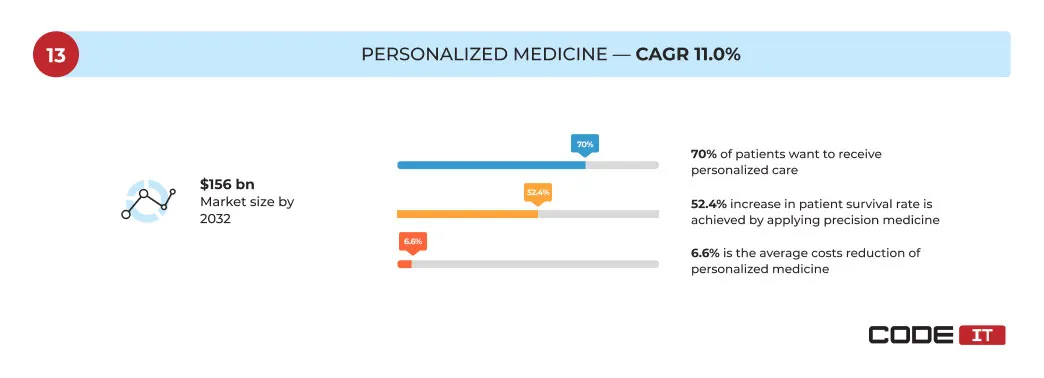
Precision medicine helps achieve better treatment outcomes.
Statistics say that the precision healthcare market is expected to double by 2030 at a CAGR of 11%.
According to PatientEngagementHIT, 70% of patients want their healthcare providers to provide precision treatment.
The research published in the National Library of Medicine reveals that the application of precision medicine helps increase the survival rate by 52.4%; personalized treatment costs are 6.6% lower compared to traditional practices.
The future of precision medicine will enable healthcare providers to tailor treatment and prevention strategies to people’s unique characteristics.
Continuous Training — CAGR 6.6%
Continuous learning is a well-defined workflow that enables continuous monitoring of the skills of healthcare professionals and training. Doctors and medical staff must learn new skills and continuously grasp up-to-date knowledge.
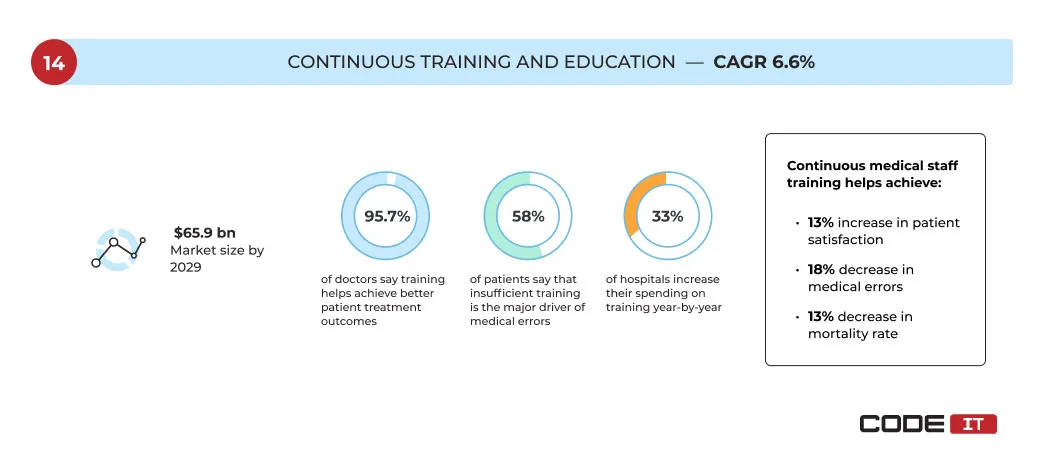
Hence, the global medical education market is growing at a CAGR of 6.6%, expecting to reach $65.9 billion by 2028, healthcare statistics 2025 say.
95.7% of medical workers believe that training helps achieve positive healthcare outcomes, the survey published by Science Direct says.
The research conducted by FierceHealthcare found that continuous staff training helps increase the patient satisfaction rate by 13%. Also, it helps cut medical errors by 18% and reduce the patient mortality rate by 13%.
As per another survey, 58% of patients who faced a medical error highlighted the poorly-trained staff as a contributing factor.
Healthcare Finance has estimated that roughly 33% of healthcare organizations increased their spending on staff training.
Electronic Health Records — CAGR 5%
Electronic health record (EHR) systems help healthcare providers to create, store, and share data about patients electronically.
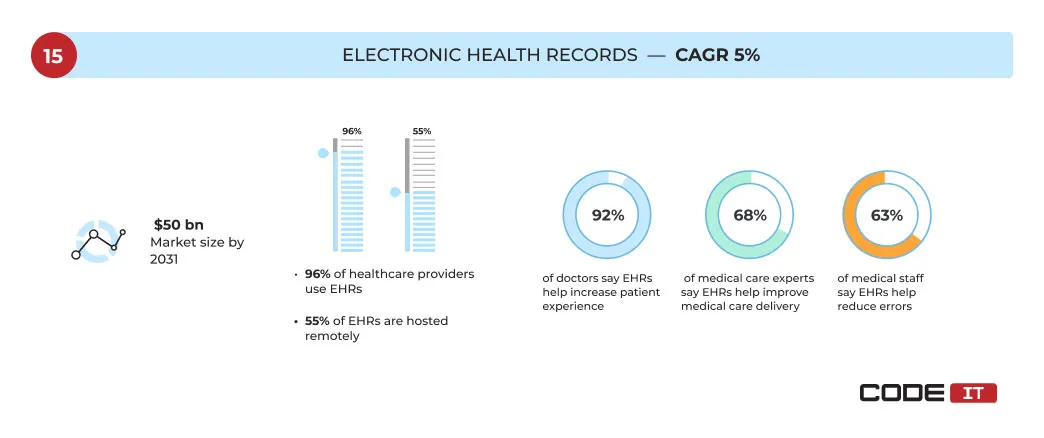
The EHR market is about to expand 2.4 times, surpassing the $50 billion milestone by 2031, statistics say. Even though the CAGR isn’t high, the EHR is still on the list of the top healthcare trends in 2025.
Also, the report highlights the positive effect of using EHR systems in healthcare organizations by revealing the following statistics.
- 92% of respondents say that EHR systems help improve patient experience
- 68% of respondents say that the usage of EHR systems helps improve clinical care delivery
- 63% of respondents say EHRs help reduce errors
As per Becker’s Healthcare, 96% of healthcare providers use EHR systems; 55% of EHRs are hosted remotely.
To Recap
The rapid adoption of AI identifies the healthcare industry trends in 2025, big data analysis, cloud computing, and other prominent technologies.
The top-15 healthcare technology trends in 2025 are:
- AI and ML — CAGR 37.5%
- Blockchain — CAGR 34%
- IoMT — CAGR 29.5%
- VR / AR — CAGR 27.2%
- Wearables technology — CAGR 26.4%
- Telemedicine — CAGR 25.7%
- Big data analytics — CAGR 24.3%
- Mobile healthcare — CAGR 22.3%
- ePrescribing — CAGR 21%
- Cloud infrastructure — CAGR 17.6%
- Security and compliance — CAGR 14.2%
- Interoperability — CAGR 12.9%
- Precisions medicine — CAGR 11.0%
- Continuous training and education — CAGR 6.6%
- Electronic health records — CAGR 5%
The healthcare niche transforms at a high pace as the implication of modern healthcare technology helps improve patient satisfaction, enhance performance, and reduce errors.
FAQ
The top five fastest-growing trends in healthcare in 2024 are:
- AI and ML — CAGR 37.5%
- Blockchain — CAGR 34%
- IoMT — CAGR 29.5%
- VR / AR — CAGR 27.2%
- Wearables technology — CAGR 26.4%
The rising healthcare trends in 2024 include the following:
- AI and ML — CAGR 37.5%
- Blockchain — CAGR 34%
- IoMT — CAGR 29.5%
- VR / AR — CAGR 27.2%
- Wearables technology — CAGR 26.4%
- Telemedicine — CAGR 25.7%
- Big data analytics — CAGR 24.3%
- Mobile healthcare — CAGR 22.3%
- ePrescribing — CAGR 21%
- Cloud infrastructure — CAGR 17.6%
- Security and compliance — CAGR 14.2%
- Interoperability — CAGR 12.9%
- Precisions medicine — CAGR 11.0%
- Continuous training and education — CAGR 6.6%
- Electronic health records — CAGR 5%
Healthcare providers rapidly adopt new technologies to enhance patient experience and improve performance. In a nutshell, the healthcare industry has become data-rich because of extensive data analysis, AI, IoMT, cloud computing, and other technologies. Also, healthcare providers adopt top-tier technologies like VR and blockchain.
According to the 2024 healthcare trends, most patients want to receive personalized medicine. Also, the top appreciated technologies patients demand are telemedicine, AI, wearables, and mobile experience.
Build your ideal
software today






